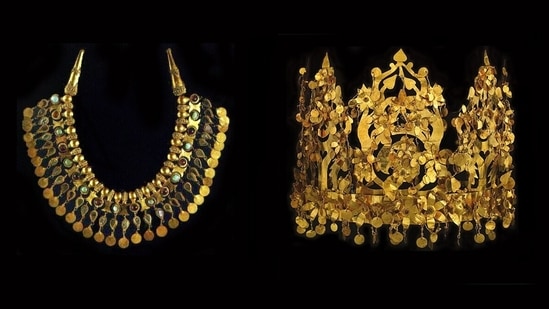The Bactrian treasure was excavated more than four decades ago from the graves of six wealthy nomads in the Tela Tapa area of Sherberghan district in northern Afghanistan.

The Taliban have said they are tracking and will secure the 2000-year-old Bactrian gold treasure. (Thierry Ollivier/Musée Guimet)
By hindustantimes.com | Written by Meenakshi Ray
PUBLISHED ON SEP 19, 2021
The Taliban have said they have begun efforts to track and locate the 2000-year-old Bactrian treasure, also known as Bactrian Gold. “The issue is under investigation, and we will collect information to know what the reality is. If it has been transferred (out of Afghanistan), it is treason against Afghanistan,” Ahmadullah Wasiq, deputy head of the cultural commission of the Taliban interim cabinet, was quoted as saying by Tolo News. “The government of Afghanistan will take serious actions if this and other ancient items are moved out of the country,” Wasiq said.
More than 20,000 artefacts
The Bactrian treasure was excavated in 1978-79 from the graves of six wealthy nomads—dating from the first century BC to the first century AD— in the Tela Tapa or Hill of Gold area of Sherberghan district in northern Afghanistan. The graves of the Saka tribesmen from Central Asia, perhaps, or the Yuezhi from northwest China, had more than 20,000 artefacts including gold cupids, dolphins, gods and dragons encrusted with semiprecious stones such as turquoise, carnelian, and lapis lazuli. They also contained golden rings, coins, weapons, earrings, bracelets, necklaces, weapons, and crowns.
Also read | Taliban to track, secure 2000-year-old Bactrian gold treasure: Report
Viktor Sarianidi, the Moscow archaeologist who led the joint Soviet-Afghan team that uncovered the graves, compared the impact of the find to the 1922 discovery of Tutankhamen's tomb. "The gold of Bactria shook the world of archaeology. Nowhere in antiquity have so many different objects from so many different cultures—Chinese-inspired boot buckles, Roman coins, daggers in a Siberian style—been found together in situ,” Sarianidi has written, according to the Smithsonian Magazine.
“The 2,000-year-old artifacts found with them exhibit a rare blend of aesthetic influences (from Persian to classical Greek) and the great number of precious objects found surprised the archaeologists, in particular the intricate golden crown found in the sixth tomb,” it added. Smithsonian Magazine said in 2009 that for example the diadem, “a five-inch-tall crown of hammered gold leaf, conveniently folds for travel, and a thumb-size gold figure of a mountain sheep is delicately incised with curving horns and flaring nostrils”.
Kushan Empire, Buddha
Sarianidi believed that the treasure had been assembled by Yuezhi nobles from China, who arrived in the Bactria region around the second century BC and later established the Kushan Empire in India. Other scholars say the hoard was interred by Scythians from modern-day Iran. “The contesting theories reveal the variety of influences that make up this huge collection of objects. Other items include a Roman coin with the head of the emperor Tiberius, a silver mirror with Chinese engravings, rings with Greek text, and a coin with Buddhist imagery,” National Geographic magazine said in 2016.
Sarianidi and his workers found a skull and skeleton surrounded by gold jewellery and ornaments during the course of the excavation. They were the remains of a woman, 25 to 30 years old, whom Sarianidi called a nomadic princess. “He subsequently found and excavated five additional graves, all simple trenches containing lidless wooden coffins holding the remains of once ornately attired bodies,” according to Smithsonian Magazine.
Sarianidi's team uncovered in the grave of a chieftain—the only man found at the site—turquoise-studded daggers and sheaths and a braided gold belt with raised medallions that bear the image riding on a panther. Some say the image is that Dionysus, the Greek god of wine, and others speculate it's the Bactrian goddess Nana seated on a lion. An Indian medallion was also found near the chieftain's rib cage by the excavators. Véronique Schiltz, a French archaeologist with the National Center for Scientific Research in Paris, has said it bears one of the earliest representations of Buddha.
The remains of a woman in her 30s were found in a nearby grave and she was wearing signet rings with images of Athena, the Greek goddess of wisdom, and a pair of matching jewelled pendants with gold figures grasping S-shaped dragons. Another grave, that of a teenage girl, contained thin gold shoe soles along with a Roman coin minted in the early first century AD in Gallic Lugdunum—present-day Lyon, France.
No comments:
Post a Comment